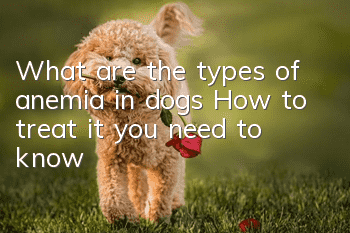What are the types of anemia in dogs? How to treat it, you need to know!

Anemia means that the number of fiber cells, hemoglobin content and hematocrit volume (specific volume) in unit volume of blood are lower than normal values. The clinical manifestations are characterized by pale mucous membranes, accelerated rate and breathing, and general weakness. Anemia can be divided into hemorrhagic anemia, hemolytic anemia, nutritional anemia and aplastic anemia.
1. Hemorrhagic anemia
[Cause] Acute hemorrhagic anemia is caused by trauma or surgery causing rupture of internal organs (such as liver, spleen, vena artery and vena cava) and external blood vessels, causing massive bleeding, resulting in a sudden decrease in the body's hemolytic capacity.
Chronic hemorrhagic anemia is mainly caused by chronic inflammation of the stomach and intestines, hemorrhagic inflammation of the lungs, kidneys, bladder, and uterus.
【Symptoms】 Common symptoms include visible mucous membranes, pale skin, rapid heartbeat, and general muscle weakness. Symptoms are proportional to the amount of bleeding. Excessive bleeding may cause collapse, restlessness, decreased blood pressure, coldness in the limbs, ears and nose, unsteady gait, and muscle tremors. In the later stage, drowsiness, coma, and shock may be seen. For dogs with small amounts of bleeding and chronic bleeding, the initial symptoms are not obvious. However, the sick dog can gradually lose weight, and the visible mucosa gradually develops from light red to white. It is listless, has general weakness, lethargy, is inactive, has a fast and weak pulse, and has shallow breathing. Slight edema of the lower jaw and limbs is often seen. Severe cases can lead to shock, heart failure and death.
[Diagnosis] According to clinical symptoms, red blood cell count and hematocrit examination can confirm the diagnosis.
【Treatment】 Stop bleeding and restore hemolysis.
① For traumatic bleeding, ligation, compression, and tourniquet can be used to stop bleeding. For bleeding at the end of the limbs, owners can use a tourniquet to stop the bleeding and immediately send them to a veterinary hospital for treatment.
② Injection of hemostatic drugs: hemostasis 25 mg/kg body weight; vitamin K 30.4 mg/kg body weight; vitamin K 11 mg/kg body weight; coagulopathy 1.5 mg/kg body weight.
③ To supplement hemolysis, dextran, glucose, compound saline, and amino acid preparations can be infused intravenously. Veterinary hospitals with conditions should provide blood transfusion therapy.
2. Hemolytic anemia
Anemia caused by massive destruction of red blood cells due to various reasons is called hemolytic anemia.
【Cause】
① Caused by infectious factors. Such as leptospirosis, herpes pathogens, trypanosomiasis, hemolytic streptococcus infection, etc.
②Toxic diseases. Heavy metal poisoning such as: lead, copper, arsenic, mercury, etc.; chemical drug poisoning: benzene, phenol, sulfa, etc. Hemolytic anemia can also be caused by police dogs inhaling TNT explosives while performing tasks.
③Antigen-antibody reaction. Hemolytic anemia in newborn dogs. Because the blood type of the newborn is different from that of the mother dog, an antigen-antibody reaction occurs after ingesting breast milk, resulting in hemolytic anemia in the puppies. Transfusion of heterotypic blood types can also cause hemolysis.
Other factors, such as febrile disease, lymphosarcoma, myeloid leukemia, plasma hemoglobinemia, red blood cell pyruvate kinase deficiency and other factors can cause hemolytic anemia.
【Symptoms】The main symptoms are visible yellowing of mucous membranes, yellowing of the corners of the skin and mouth, depression, weakness in movement, and weight loss. In the later stage, white and yellow mucous membranes, lethargy, hemoglobinuria, and body weight loss can be seen.
【Treatment】 Expand the hemolysis volume, remove the cause, and treat symptomatically.
Rehydration and blood transfusion therapy. For toxic diseases, antidotes are given; for parasitic infections, insecticides are given for treatment. Also combined with hormonal therapy, such as cortisone, prednisone, and dexamethasone.
- Why does the dog keep shaking?
- Things to note when breeding Teddy
- What are the causes of bad mouth in dogs?
- Learn how to feed scientifically, and your Labrador will not be far from a racing dog
- How to treat diarrhea in a two-day-old dog
- Why do dogs keep biting their own tails?
- What dogs should not eat during pregnancy Precautions for dogs during pregnancy
- Most dogs over the age of three suffer from various dental diseases
- How to take care of your dog when he is sick
- American Urine off urea can effectively reduce canine leptospirosis virus??



